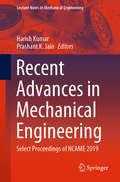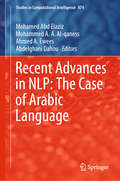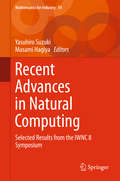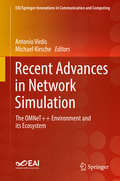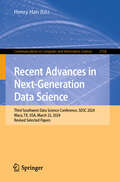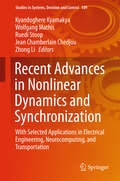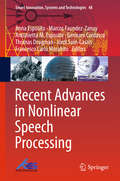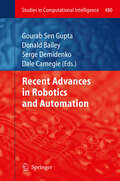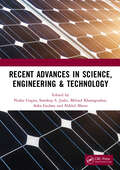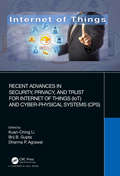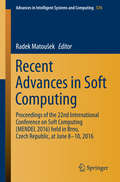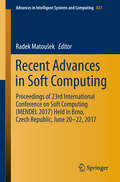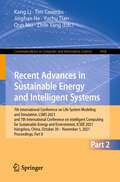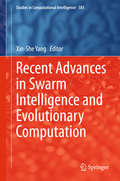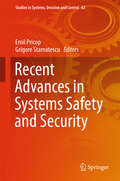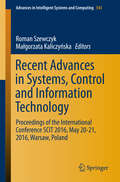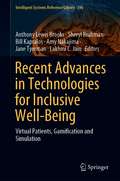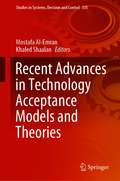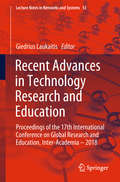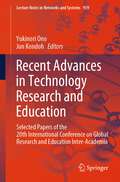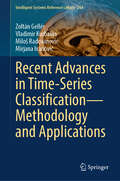- Table View
- List View
Recent Advances in Mechanical Engineering: Select Proceedings of ITME 2019 (Lecture Notes in Mechanical Engineering)
by Harish Kumar Mohammad Muzammil Arunesh Chandra Pavan Kumar KankarThis book presents selected peer-reviewed papers presented at the International Conference on Innovative Technologies in Mechanical Engineering (ITME) 2019. The book discusses a wide range of topics in mechanical engineering such as mechanical systems, materials engineering, micro-machining, renewable energy, systems engineering, thermal engineering, additive manufacturing, automotive technologies, rapid prototyping, computer aided design and manufacturing. This book, in addition to assisting students and researchers working in various areas of mechanical engineering, can also be useful to researchers and professionals working in various allied and interdisciplinary fields.
Recent Advances in Mechanical Engineering: Select Proceedings of NCAME 2019 (Lecture Notes in Mechanical Engineering)
by Harish Kumar Prashant K. JainThis book presents the selected peer-reviewed papers from the National Conference on Advances in Mechanical Engineering (NCAME 2019), held at the National Institute of Technology Delhi, India. The book covers different areas of mechanical engineering from design engineering to manufacturing engineering. A wide range of topics are discussed such as CAD/CAM, additive manufacturing, fluid dynamics, materials science and engineering, simulation and modeling, finite element analysis, applied mechanics to name a few. The contents provide an overview of the state-of-the-art in mechanical engineering research in the country. Given the scope of the topics covered, the book will be of interest for students, researchers and professionals working in mechanical engineering.
Recent Advances in Mechanics and Fluid-Structure Interaction with Applications: The Bong Jae Chung Memorial Volume (Advances in Mathematical Fluid Mechanics)
by Fernando Carapau Ashwin VaidyaThis volume examines current research in mechanics and its applications to various disciplines, with a particular focus on fluid-structure interaction (FSI). The topics have been chosen in commemoration of Dr. Bong Jae Chung and with respect to his wide range of research interests. This volume stands apart because of this diversity of interests, featuring an interdisciplinary and in-depth analysis of FSI that is difficult to find conveniently collected elsewhere in the literature. Contributors include mathematicians, physicists, mechanical and biomechanical engineers, and psychologists. This volume is structured into four thematic areas in order to increase its accessibility: theory, computations, experiments, and applications. Recent Advances in Mechanics and Fluid-Structure Interaction with Applications will appeal to established researchers as well as postdocs and graduate students interested in this active area of research.
Recent Advances in NLP: The Case of Arabic Language (Studies in Computational Intelligence #874)
by Mohamed Abd Elaziz Mohammed A. A. Al-qaness Ahmed A. Ewees Abdelghani DahouIn light of the rapid rise of new trends and applications in various natural language processing tasks, this book presents high-quality research in the field. Each chapter addresses a common challenge in a theoretical or applied aspect of intelligent natural language processing related to Arabic language. Many challenges encountered during the development of the solutions can be resolved by incorporating language technology and artificial intelligence.The topics covered include machine translation; speech recognition; morphological, syntactic, and semantic processing; information retrieval; text classification; text summarization; sentiment analysis; ontology construction; Arabizi translation; Arabic dialects; Arabic lemmatization; and building and evaluating linguistic resources.This book is a valuable reference for scientists, researchers, and students from academia and industry interested in computational linguistics and artificial intelligence, especially for Arabic linguistics and related areas.
Recent Advances in Natural Computing
by Yasuhiro Suzuki Masami HagiyaThis book highlights recent advances in natural computing, including biology and its theory, bio-inspired computing, computational aesthetics, computational models and theories, computing with natural media, philosophy of natural computing and educational technology. It presents extended versions of the best papers selected from the symposium "7th International Workshop on Natural Computing" (IWNC7), held in Tokyo, Japan, in 2013. The target audience is not limited to researchers working in natural computing but also those active in biological engineering, fine/media art design, aesthetics and philosophy.
Recent Advances in Network Simulation: The OMNeT++ Environment and its Ecosystem (EAI/Springer Innovations in Communication and Computing)
by Antonio Virdis Michael KirscheThis book provides a comprehensive introduction to the OMNeT++ simulation environment and an overview of its ecosystem of ever-growing frameworks, which provide simulation models for diverse communication systems, protocols, and standards. The book covers the most recent advances of the three key points in the OMNeT++ environment: (1) The latest features that are being added to OMNeT++ itself, including improvements in the visualization options, in data processing, etc. (2) A comprehensive description of the current state of development and the work in progress of the main simulation frameworks, covering several aspects of communication such as vehicular, cellular, and sensor networks. (3) The latest advances and novel developments coming from a large research community. The presentation is guided through use cases and examples, always keeping in mind the practical and research purposes of the simulation process. Includes an introduction to the OMNeT++ simulation framework and its main features;Gives a comprehensive overview of ongoing research topics that exploits OMNeT++ as the simulation environment;Provides examples and uses cases focusing on the practical aspects of simulation.
Recent Advances in Next-Generation Data Science: Third Southwest Data Science Conference, SDSC 2024, Waco, TX, USA, March 22, 2024, Revised Selected Papers (Communications in Computer and Information Science #2158)
by Henry HanThis book constitutes the refereed proceedings of the Third Southwest Data Science Conference, on Recent advances in next-generation data science, SDSC 2024, held in Waco, TX, USA, in March 22, 2024. The 15 full papers presented were carefully reviewed and selected from 59 submissions. These papers focus on AI security in next-generation data science and address a range of challenges, from protecting sensitive data to mitigating adversarial threats.
Recent Advances in Nonlinear Dynamics and Synchronization
by Ruedi Stoop Zhong Li Kyandoghere Kyamakya Wolfgang Mathis Jean Chamberlain ChedjouIn essence, the dynamics of real world systems (i. e. engineered systems, natural systems, social systesms, etc. ) is nonlinear. The analysis of this nonlinear character is generally performed through both observational and modeling processes aiming at deriving appropriate models (mathematical, logical, graphical, etc. ) to simulate or mimic the spatiotemporal dynamics of the given systems. The complex intrinsic nature of these systems (i. e. nonlinearity and spatiotemporal dynamics) can lead to striking dynamical behaviors such as regular or irregular, stable or unstable, periodicity or multi-periodicity, torus or chaotic dynamics. The various potential applications of the knowledge about such dynamics in technical sciences (engineering) are being intensively demonstrated by diverse ongoing research activities worldwide. However, both the modeling and the control of the nonlinear dynamics in a range of systems is still not yet well-understood (e. g. system models with time varying coefficients, immune systems, swarm intelligent systems, chaotic and fractal systems, stochastic systems, self-organized systems, etc. ). This is due amongst others to the challenging task of establishing a precise and systematic fundamental or theoretical framework (e. g. methods and tools) to analyze, understand, explain and predict the nonlinear dynamical behavior of these systems, in some cases even in real-time. The full insight in systems' nonlinear dynamic behavior is generally achieved through approaches involving analytical, numerical and/or experimental methods.
Recent Advances in Nonlinear Speech Processing
by Anna Esposito Marcos Faundez-Zanuy Antonietta M. Esposito Gennaro Cordasco Thomas Drugman Jordi Solé-Casals Francesco Carlo MorabitoThis book presents recent advances in nonlinearspeech processing beyond nonlinear techniques. It shows that it exploitsheuristic and psychological models of human interaction in order to succeed inthe implementations of socially believable VUIs and applications for humanhealth and psychological support. The book takes into account themultifunctional role of speech and what is "outside of the box" (see BjörnSchuller's foreword). To this aim, the book is organized in 6 sections, eachcollecting a small number of short chapters reporting advances "inside" and"outside" themes related to nonlinear speech research. The themes emphasizetheoretical and practical issues for modelling socially believable speechinterfaces, ranging from efforts to capture the nature of sound changes inlinguistic contexts and the timing nature of speech; labors to identify anddetect speech features that help in the diagnosis of psychological and neuronaldisease, attempts to improve the effectiveness and performance of Voice UserInterfaces, new front-end algorithms for the coding/decoding of effective andcomputationally efficient acoustic and linguistic speech representations, aswell as investigations capturing the social nature of speech in signalingpersonality traits, emotions and improving human machine interactions.
Recent Advances in Robotics and Automation
by Dale Carnegie Donald Bailey Gourab Sen Gupta Serge DemidenkoThere isn't a facet of human life that has not been touched and influenced by robots and automation. What makes robots and machines versatile is their computational intelligence. While modern intelligent sensors and powerful hardware capabilities have given a huge fillip to the growth of intelligent machines, the progress in the development of algorithms for smart interaction, collaboration and pro-activeness will result in the next quantum jump. This book deals with the recent advancements in design methodologies, algorithms and implementation techniques to incorporate intelligence in robots and automation systems. Several articles deal with navigation, localization and mapping of mobile robots, a problem that engineers and researchers are grappling with all the time. Fuzzy logic, neural networks and neuro-fuzzy based techniques for real world applications have been detailed in a few articles. This edited volume is targeted to present the latest state-of-the-art computational intelligence techniques in Robotics and Automation. It is a compilation of the extended versions of the very best papers selected from the many that were presented at the 5th International Conference on Automation, Robotics and Applications (ICARA 2011) which was held in Wellington, New Zealand from 6-8 December, 2011. Scientists and engineers who work with robots and automation systems will find this book very useful and stimulating.
Recent Advances in Science, Engineering & Technology: International Conference on Recent Advances in Science, Engineering & Technology
by Nishu Gupta Milind Khanapurkar Asha Gedam Nikhil Bhave Sandeep S. JoshiThe advances in technology, engineering and science are necessary for better and sustailable life. It is not only beneficial for human growth but equally important for all the living and non living matters on the planet. Hence it is imperative to come togather and share the knowledge, innovations and developments in the technology and science happening around. The objective of 1st International Conference on “Recent Advances in Science, Engineering & Technology” (ICRASET-2023) was to provide platform to share various hypotheses, conclusions, and discoveries from students, researchers, professors, and industry experts. The conference was associated with the knowledge partners like ASM International, IEEE, IETE, ISTE, CSI and IE
Recent Advances in Security, Privacy, and Trust for Internet of Things (IoT) and Cyber-Physical Systems (CPS)
by Kuan-Ching Li Brij B. Gupta Dharma P. AgrawalSecurity, privacy, and trust in the Internet of Things (IoT) and CPS (Cyber-Physical Systems) are different from conventional security as concerns revolve around the collection and aggregation of data or transmission of data over the network. Analysis of cyber-attack vectors and the provision of appropriate mitigation techniques are essential research areas for these systems. Adoption of best practices and maintaining a balance between ease of use and security are, again, crucial for the effective performance of these systems. Recent Advances in Security, Privacy and Trust for Internet of Things (IoT) and Cyber-Physical Systems (CPS) discusses and presents techniques and methodologies, as well as a wide range of examples and illustrations, to effectively show the principles, algorithms, challenges, and applications of security, privacy, and trust for IoT and CPS. Book features: Introduces new directions for research, development, and engineering security, privacy, and trust of IoT and CPS Includes a wealth of examples and illustrations to effectively demonstrate the principles, algorithms, challenges, and applications Covers most of the important security aspects and current trends not present in other reference books This book will also serve as an excellent reference in security, privacy, and trust of IoT and CPS for professionals in this fast-evolving and critical field. The chapters present high-quality contributions from researchers, academics, and practitioners from various national and international organizations and universities.
Recent Advances in Smart Manufacturing and Materials: Select Proceedings of ICEM 2020 (Lecture Notes in Mechanical Engineering)
by Rajeev Agrawal Jinesh Kumar Jain Vinod Singh Yadav Vijaya Kumar Manupati Leonilde VarelaThis book presents select proceedings of the International Conference on Evolution in Manufacturing (ICEM 2020), and examines a range of areas including internet-of-things for cyber manufacturing, data analytics for manufacturing systems and processes and materials. The topics covered include modeling simulation and decision making in cyber physical systems for supporting engineering and production management, innovative approach in materials development, biomaterial applications, and advancement in manufacturing and material technologies. The book also discusses sustainability in manufacturing and supply chain management including circular economy. The book will be a valuable reference for beginners, researchers, and professionals interested in smart manufacturing in engineering, production management and materials technology.
Recent Advances in Soft Computing
by Radek MatoušekThis proceeding book contains a collection of selected accepted papers of the Mendel conference held in Brno, Czech Republic in June 2016. The proceedings book contains three chapters which present recent advances in soft computing including intelligent image processing. The Mendel conference was established in 1995 and is named after the scientist and Augustinian priest Gregor J. Mendel who discovered the famous Laws of Heredity. The main aim of the conference is to create a regular possibility for students, academics and researchers to exchange ideas and novel research methods on a yearly basis.
Recent Advances in Soft Computing and Data Mining: Proceedings of the Fifth International Conference on Soft Computing and Data Mining (SCDM 2022), May 30-31, 2022 (Lecture Notes in Networks and Systems #457)
by Jemal H. Abawajy Rozaida Ghazali Nazri Mohd Nawi Mustafa Mat Deris Nureize ArbaiyThis book unfolds ways to transform data into innovative solutions perceived as new remarkable and meaningful value. It offers practical views of the concepts and techniques readers need to get the most out of their large-scale research and data mining projects. It strides them through the data-analytical thinking, circumvents the difficulty in deciphering complex data systems and obtaining commercialization value from the data. Also known as data-driven science, soft computing and data mining disciplines cover a broad spectrum, an interdisciplinary field of scientific methods and processes. The book, Recent Advances in Soft Computing and Data Mining, delivers sufficient knowledge to tackle a wide range of issues seen in complex systems. This is done by exploring a vast combination of practices and applications by incorporating these two domains. To thrive in these data-driven ecosystems, researchers, data analysts, and practitioners must choose the best design to approach the problem with the most efficient tools and techniques. To thrive in these data-driven ecosystems, researchers, data analysts, and practitioners must understand the design choice and options of these approaches, thus to better appreciate the concepts, tools, and techniques used.
Recent Advances in Soft Computing: Proceedings of 23rd International Conference on Soft Computing (MENDEL 2017) Held in Brno, Czech Republic, June 20-22, 2017 (Advances in Intelligent Systems and Computing #837)
by Radek MatoušekThis book presents selected papers from the MENDEL conference that was held in Brno, Czech Republic in June 2017. Consisting of two parts, the book discusses recent advances in soft computing, including intelligent image processing: Part 1 addresses evolutionary computing, swarm intelligence, metaheuristics, and optimization; Part 2 then focuses on neural networks, machine learning, self-organization, fuzzy systems, and advanced statistics. The MENDEL conference was established in 1995 and it bears the name of the scientist and Augustinian priest Gregor J. Mendel, who discovered the famous Laws of Heredity. The main aim of the conference was to create a regular opportunity for students, academics and researchers to exchange their ideas and novel research methods.
Recent Advances in Sustainable Energy and Intelligent Systems: 7th International Conference on Life System Modeling and Simulation, LSMS 2021 and 7th International Conference on Intelligent Computing for Sustainable Energy and Environment, ICSEE 2021, Hangzhou, China, October 30 – November 1, 2021, Proceedings, Part II (Communications in Computer and Information Science #1468)
by Kang Li Jinghan He Qun Niu Zhile Yang Tim Coombs Yuchu TianThe three-volume set CCIS 1467, CCIS 1468, and CCIS 1469 constitutes the thoroughly refereed proceedings of the 7th International Conference on Life System Modeling and Simulation, LSMS 2021, and of the 7th International Conference on Intelligent Computing for Sustainable Energy and Environment, ICSEE 2021, held in Hangzhou, China, in October 2021. The 159 revised papers presented were carefully reviewed and selected from over 430 submissions.The papers of this volume are organized in topical sections on: Medical Imaging and Analysis Using Intelligence Computing; Biomedical signal processing, imaging, visualization and surgical robotics; Computational method in taxonomy study and neural dynamics; Intelligent medical apparatus, clinical applications and intelligent design of biochips; Power and Energy Systems; Computational Intelligence in Utilization of Clean and Renewable Energy Resources, and Intelligent Modelling, Control and Supervision for Energy Saving and Pollution Reduction; Intelligent Methods in Developing Electric Vehicles, Engines and Equipment; Intelligent Control Methods in Energy Infrastructure Development and Distributed Power Generation Systems; Intelligent Modeling, Simulation and Control of Power Electronics and Power Networks; Intelligent Techniques for Sustainable Energy and Green Built Environment, Water Treatment and Waste Management; Intelligent Robot and Simulation; Intelligent Data Processing, Analysis and Control in Complex Systems; Advanced Neural Network Theory and Algorithms; Advanced Computational Methods and Applications; Fuzzy, Neural, and Fuzzy-neuro Hybrids; Intelligent Modelling, Monitoring, and Control of Complex Nonlinear Systems; Intelligent manufacturing, autonomous systems, intelligent robotic systems; Computational Intelligence and Applications.
Recent Advances in Swarm Intelligence and Evolutionary Computation
by Xin-She YangThis timely review volume summarizes the state-of-the-art developments in nature-inspired algorithms and applications with the emphasis on swarm intelligence and bio-inspired computation. Topics include the analysis and overview of swarm intelligence and evolutionary computation, hybrid metaheuristic algorithms, bat algorithm, discrete cuckoo search, firefly algorithm, particle swarm optimization, and harmony search as well as convergent hybridization. Application case studies have focused on the dehydration of fruits and vegetables by the firefly algorithm and goal programming, feature selection by the binary flower pollination algorithm, job shop scheduling, single row facility layout optimization, training of feed-forward neural networks, damage and stiffness identification, synthesis of cross-ambiguity functions by the bat algorithm, web document clustering, truss analysis, water distribution networks, sustainable building designs and others. As a timely review, this book can serve as an ideal reference for graduates, lecturers, engineers and researchers in computer science, evolutionary computing, artificial intelligence, machine learning, computational intelligence, data mining, engineering optimization and designs.
Recent Advances in Systems Safety and Security
by Emil Pricop Grigore StamatescuThis book represents a timely overview of advances in systems safety and security, based on selected, revised and extended contributions from the 2nd and 3rd editions of the International Workshop on Systems Safety and Security - IWSSS, held in 2014 and 2015, respectively, in Bucharest, Romania. It includes 14 chapters, co-authored by 34 researchers from 7 countries. The book provides an useful reference from both theoretical and applied perspectives in what concerns recent progress in this area of critical interest. Contributions, broadly grouped by core topic, address challenges related to information theoretic methods for assuring systems safety and security, cloud-based solutions, image processing approaches, distributed sensor networks and legal or risk analysis viewpoints. These are mostly accompanied by associated case studies providing additional practical value and underlying the broad relevance and impact of the field.
Recent Advances in Systems, Control and Information Technology
by Roman Szewczyk Małgorzata KaliczyńskaThis book presents the proceedings of the International Conference on Systems, Control and Information Technologies 2016. It includes research findings from leading experts in the fields connected with INDUSTRY 4. 0 and its implementation, especially: intelligent systems, advanced control, information technologies, industrial automation, robotics, intelligent sensors, metrology and new materials. Each chapter offers an analysis of a specific technical problem followed by a numerical analysis and simulation as well as the implementation for the solution of a real-world problem.
Recent Advances in Technologies for Inclusive Well-Being: Virtual Patients, Gamification and Simulation (Intelligent Systems Reference Library #196)
by Lakhmi C. Jain Anthony Lewis Brooks Bill Kapralos Jane Tyerman Sheryl Brahman Amy NakajimaIn a time of ongoing pandemic when well-being is a priority this volume presents latest works across disciplines associated to Virtual Patients, Gamification and Simulation. Chapters herein present international perspectives with authors from around the globe contributing to this impactful third edition to the series following a 2014 Springer book on Technologies for Inclusive Well-Being and a 2017 Springer book Recent Advances in Technologies for Inclusive Well-Being. Digital technologies are pervasive in life and the contributions herein focus on specific attributes and situations, especially in training and treatment programmes spanning across ranges of diagnosis, conditions, ages, and targeted impacts. This volume purposefully does not cover all (even if that was possible) aspects on how virtual interactive space can align to statial computing, which in turn can align with related embodied entities (whatever the terms used e.g. Virtual, Augmented, Extended, Mixed Realities) along with AI, Deep Learning etc. It also doesn’t cover what some may refer to as ‘trendy terms’ such as 360 degree, video, WebXR, cryptocurrency, blockchain, virtual goods, AR museums, travel and teleportation…however, what is covered in this book, and the prior volumes it builds upon (as above), is a sharing and questioning of advancing technologies for inclusive well-being through research and practices from an avant-garde perspective.
Recent Advances in Technology Acceptance Models and Theories (Studies in Systems, Decision and Control #335)
by Khaled Shaalan Mostafa Al-EmranThis book tackles the latest research trends in technology acceptance models and theories. It presents high-quality empirical and review studies focusing on the main theoretical models and their applications across various technologies and contexts. It also provides insights into the theoretical and practical aspects of different technological innovations that assist decision-makers in formulating the required policies and procedures for adopting a specific technology.
Recent Advances in Technology Research and Education: Proceedings Of The 17th International Conference On Global Research And Education Inter-academia - 2018 (Lecture Notes in Networks and Systems #53)
by Giedrius LaukaitisThis book presents the proceedings of the 17th International Conference on Global Research and Education, Inter-Academia 2018 held in Kaunas, Lithuania on 24–27 September 2018. The main goal of the conference was to provide an international forum to review, stimulate, and understand the recent trends in both fundamental and applied research. In addition to increasing interest in recent research findings, the conference aimed to strengthen the cooperation between the partners of the Inter-Academia community towards new theoretical and practical research advances. The papers included cover topics in the fields of material science and technology, nanotechnology, plasma physics, biotechnology and environmental engineering, electric and electronic engineering, robotics, measurement, identification, and control, soft computing techniques and modeling, multimedia and e-Learning. The book is a valuable scientific reference resource for the global scientific community.
Recent Advances in Technology Research and Education: Selected Papers of the 20th International Conference on Global Research and Education Inter-Academia (Lecture Notes in Networks and Systems #939)
by Yukinori Ono Jun KondohThis book presents the 20th edition of the Inter-Academia Conference which aims to be a valuable resource for academic institutions in search for novel approaches for a global education, for industry partners exploring new fundamental research ideas, for government bodies seeking international projects that promote sustainable growth, and most certainly for the global scientific community, more and more invested in the multi-disciplinarity of modern research. Interdisciplinary research collaboration is crucial for solving many pressing issues and challenges facing society today. Bringing together researchers and educators from different disciplines allows a more holistic understanding of complex problems, providing also the opportunity for new learning and for collaboration on complex projects. Beyond its scientific merits and value, Inter-Academia also promotes a culture of intellectual diversity, innovative thinking, and global perspective that can foster breakthrough discoveries, unexpected advancements in research, and, last but not least, a sense of belonging to a global community. Being established in 2002, the Inter-Academia Community currently gathers researchers from 14 leading Universities in Eastern and Central Europe, together with Shizuoka University, in Japan. As such, the Inter-Academia Community serves as a strong bond across continents, allowing the development of a number of global projects for student and researcher mobility, with a significant impact on the broader scientific community. The peer-reviewed papers included in this book hopefully stimulate further interactions and collaborations covering both fundamental and applied research, with benefits for the global society.
Recent Advances in Time-Series Classification—Methodology and Applications (Intelligent Systems Reference Library #264)
by Mirjana Ivanović Miloš Radovanović Zoltán Gellér Vladimir KurbalijaThis book examines the impact of such constraints on elastic time-series similarity measures and provides guidance on selecting suitable measures. Time-series classification frequently relies on selecting an appropriate similarity or distance measure to compare time series effectively, often using dynamic programming techniques for more robust results. However, these techniques can be computationally demanding, which results in the usage of global constraints to reduce the search area in the dynamic programming matrix. While these constraints cut computation time significantly (by up to three orders of magnitude), they may also affect classification accuracy. Additionally, the importance of the nearest neighbor classifier (1NN) is emphasized for its strong performance in time-series classification, alongside the kNN classifier which offers stable results. This book further explores the weighted kNN classifier, which gives closer neighbors more influence, showing how it merges accuracy and stability for improved classification outcomes.

